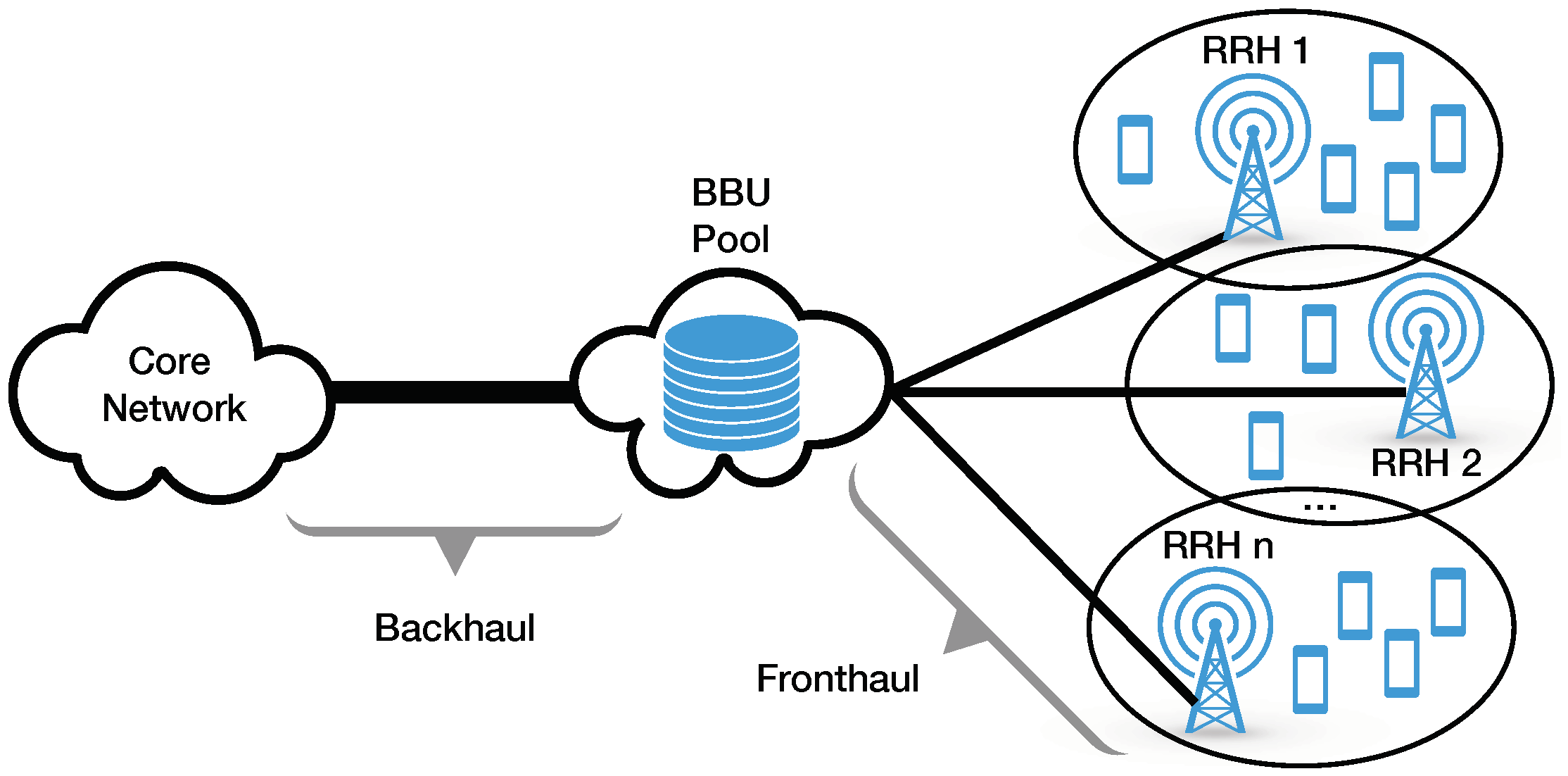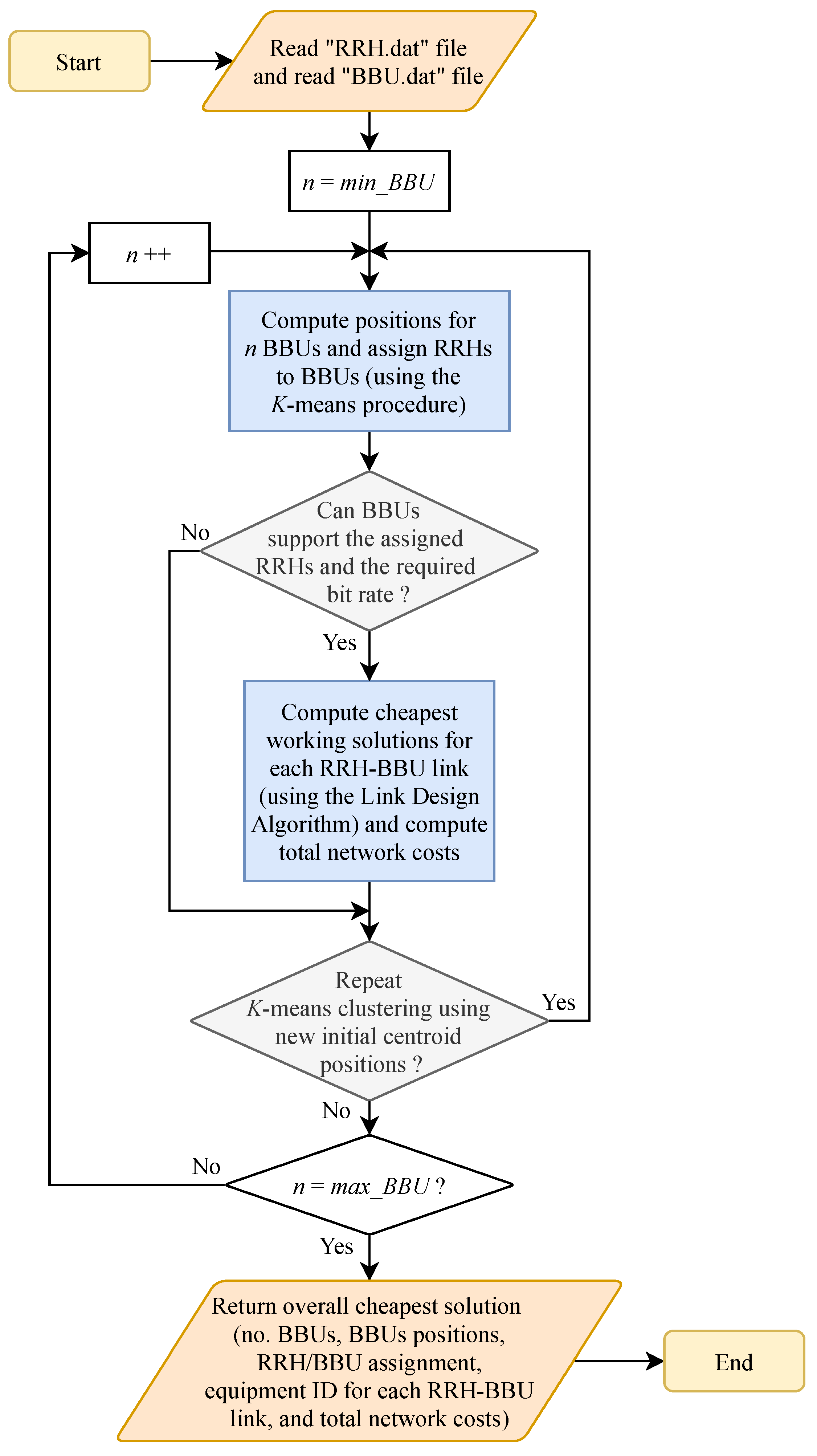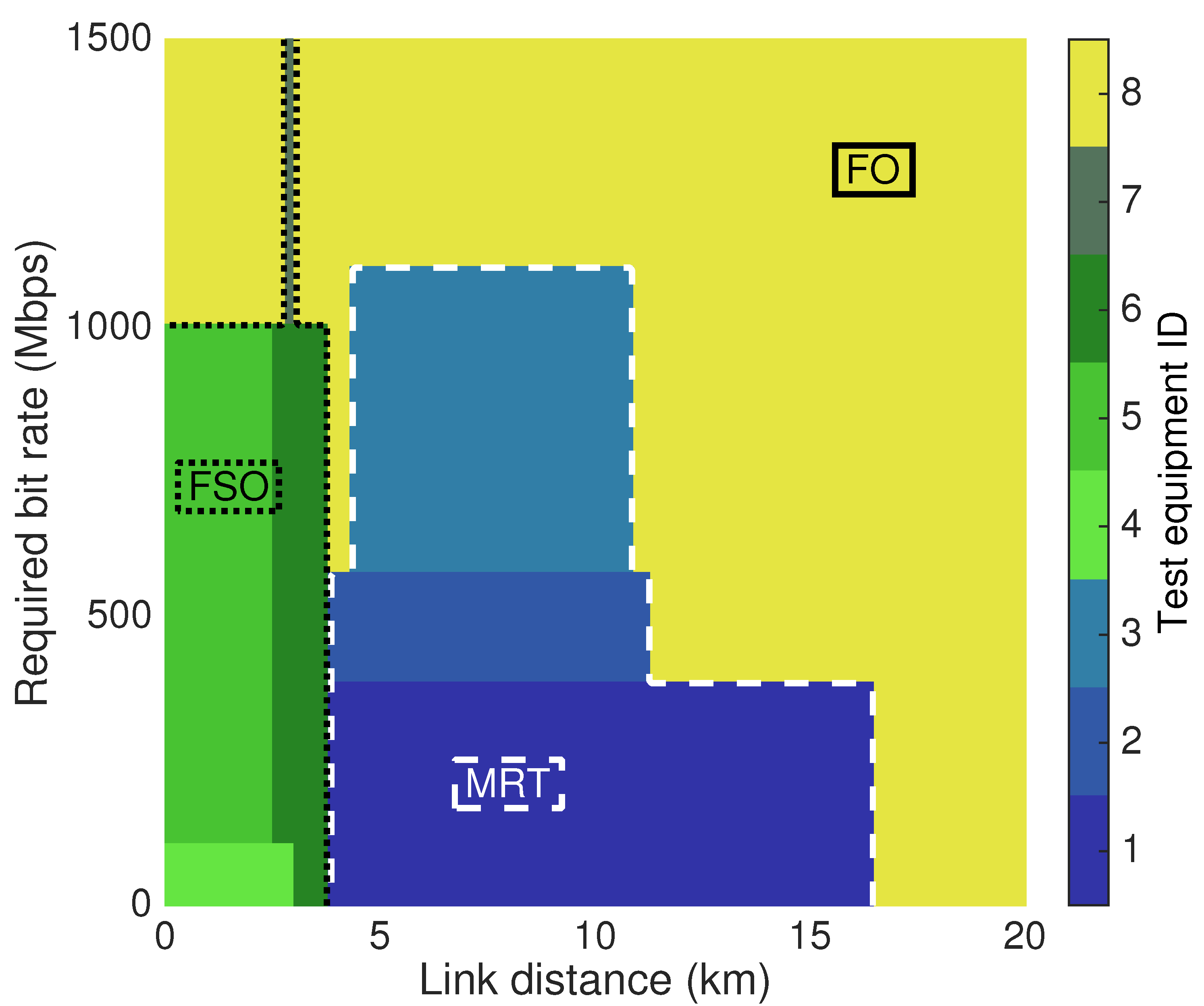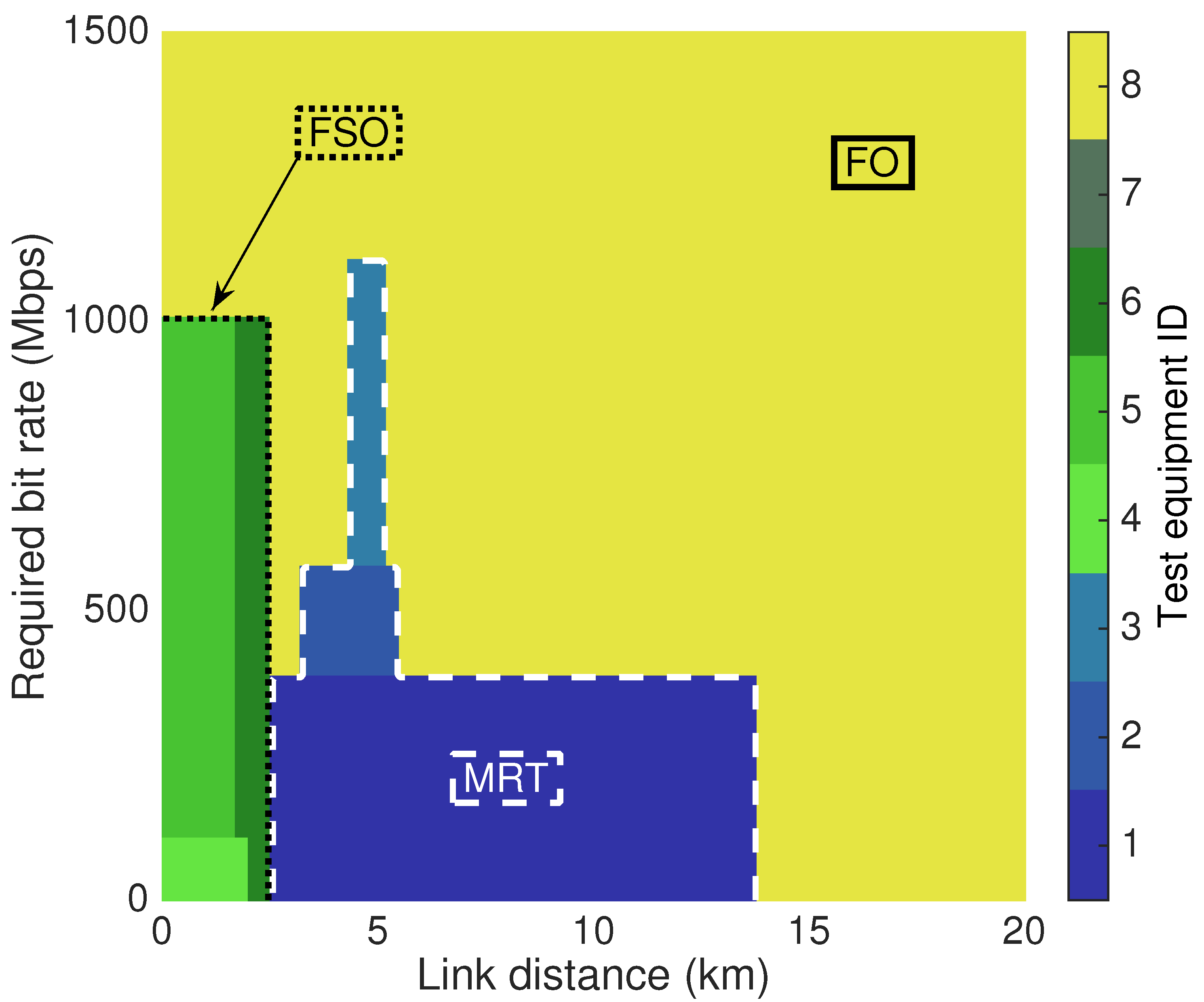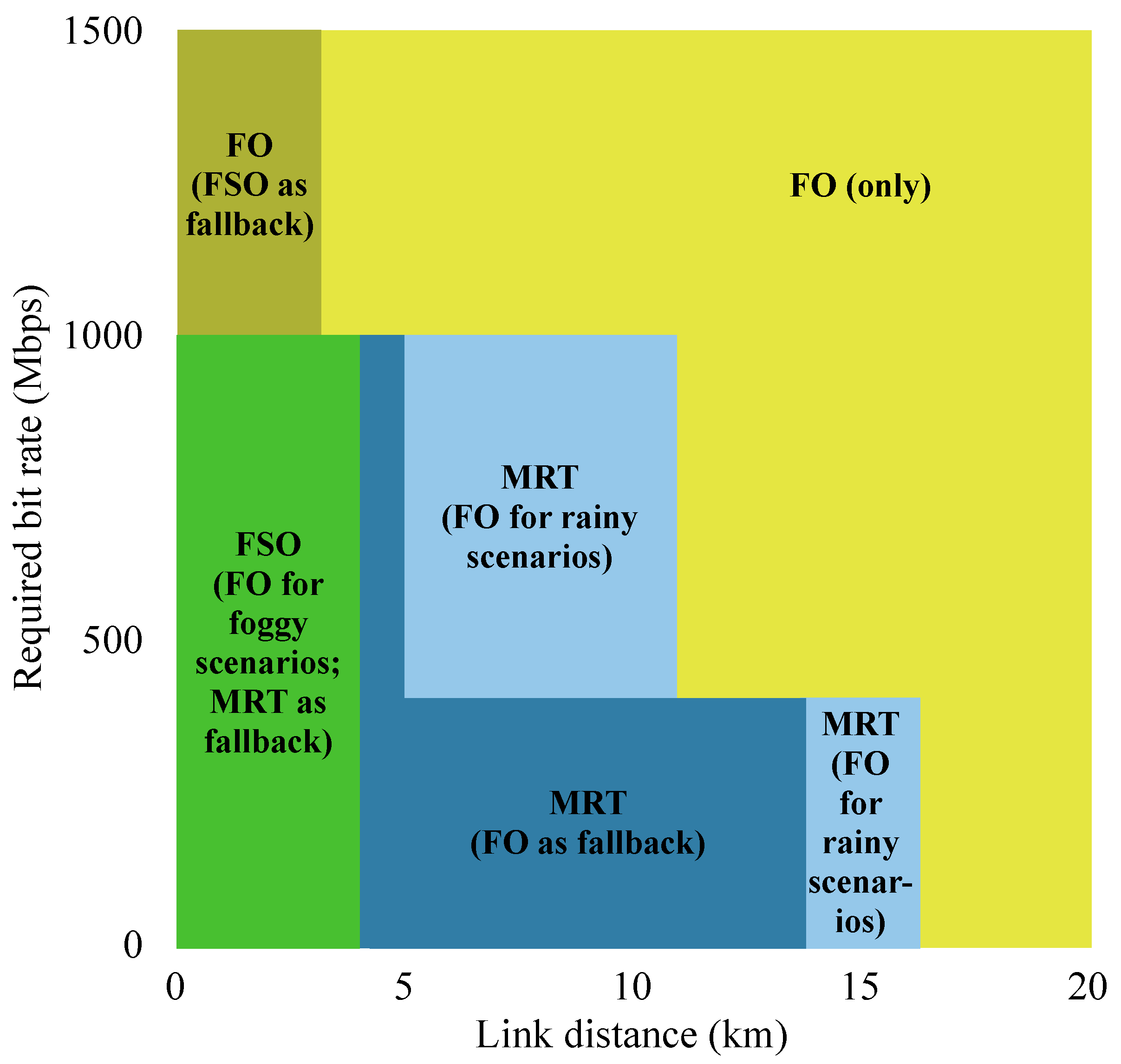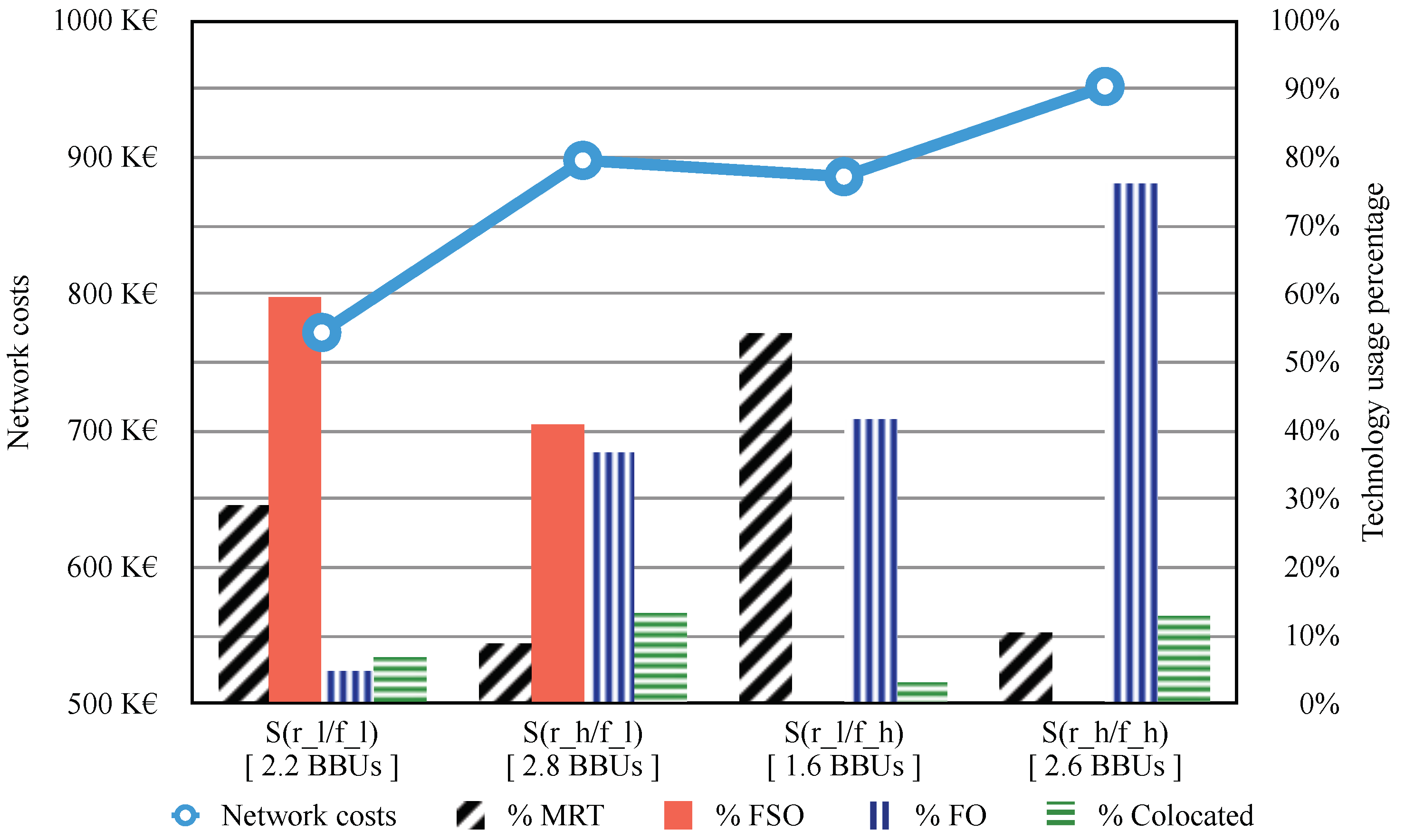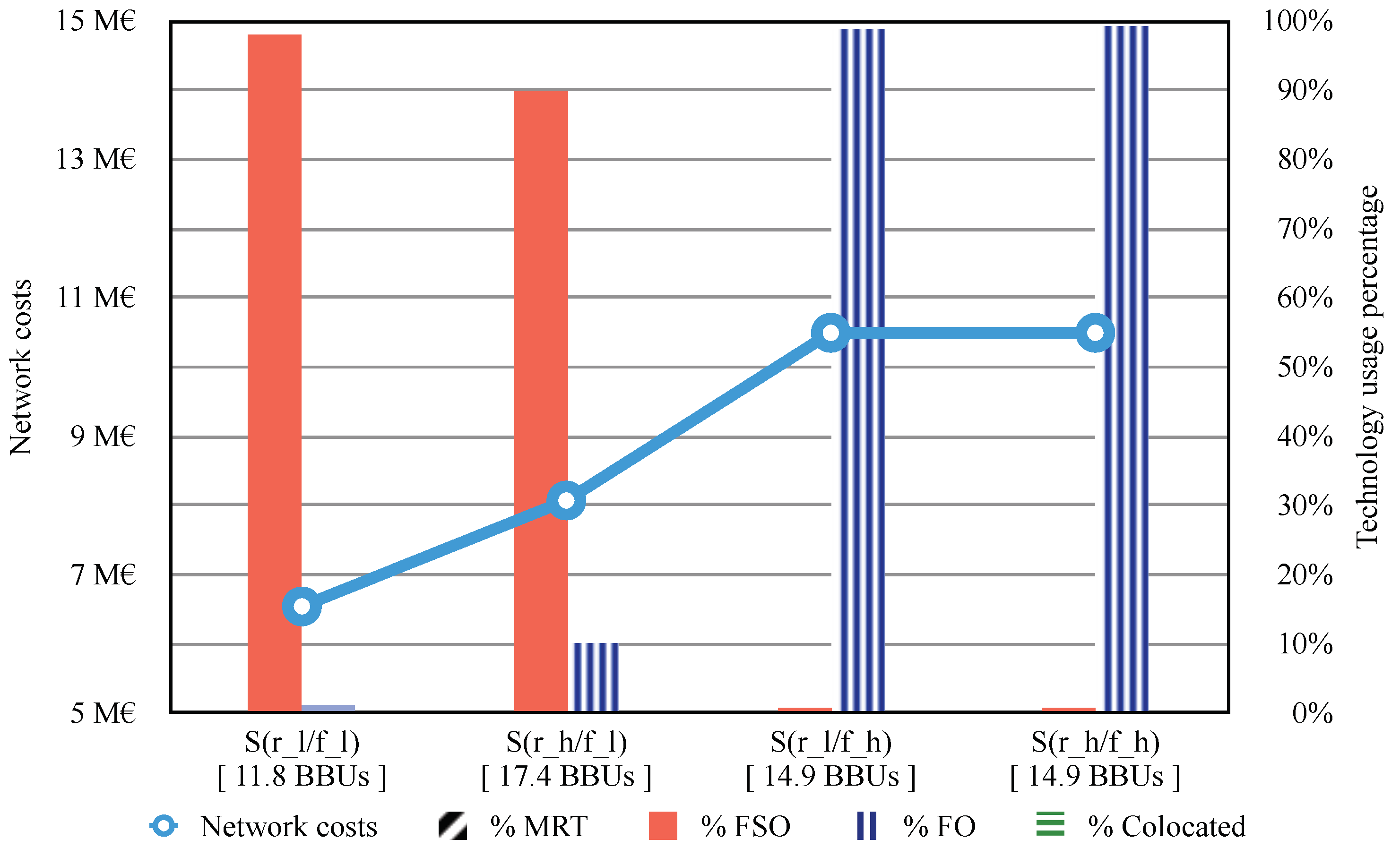The link design algorithm determines, out of all the user-specified equipment characteristics associated with one or more of the communication technologies (MRT, FSO, and FO), which is the most cost-effective solution to connect two points under user-specified link conditions; for a set of specifications, namely the equipment features and other installation aspects (such as link distance, required bit rate, and surrounding environment characteristics), this algorithm computes the cheapest solution that is able to deliver the necessary bit rate, while satisfying a certain link margin and error criteria.
With respect to the wireless technologies addressed herein (MRT and FSO), it is important to mention that only single-hop links are considered by the algorithm, because the inclusion of relay stations is not straightforward (e.g., sites for relay deployment may not be available) and leads to more complex business models (e.g., the addition of rental expenses for the extra sites). Accordingly, link distance is henceforth regarded as hop distance when MRT and FSO technologies are under consideration.
The following subsections present the details of the link design algorithm, namely the adopted models for the communication technologies, the economic analysis methodology, and finally, the workflow of the algorithm.
3.1.1. Communication Technologies Models
For wireless communication technologies such as MRT and FSO, the received signal power,
, is given by (in logarithmic units):
where
corresponds to the transmitted power (in dBW or dBm),
and
stand for the transmitter and receiver antenna gains (in dBi), respectively, and
represents the free-space path loss (in dB), i.e.,
where
d denotes the link distance and
f refers to the carrier frequency,
denotes the losses (in dB) related to equipment like cables, modulators, etc. (which are typically lower than 3 dB), and
corresponds to other losses (in dB) related to specific attenuation factors regarding the considered communication technology.
With respect to MRT systems, the term
incorporates the attenuation caused by obstacles in the line-of-sight path (
), the attenuation induced by atmospheric gases (
), and the attenuation due to rain (
). All these attenuation factors can be computed as described in the related literature [
13]; a summary is given as follows. The attenuation due to obstacles can be computed as (in dB):
where
is proportional to the amount of the Fresnel ellipsoid that is obstructed by the obstacle, i.e.,
where
denotes the height of the top of the obstacle above the straight line joining the two ends of the link (if the height is below this line, then
is negative). The attenuation due to atmospheric gases (namely uncondensed water vapor and oxygen) can be computed as (in dB):
where
and
represent, respectively, the attenuation caused by oxygen and water by units of length; values for these parameters can be extracted from nonlinear curves as a function of the carrier frequency. With respect to
, it should be pointed out that since rain is highly variable over time and differs from place to place, the respective attenuation factor depends on the desired time availability for the MRT link. More specifically, the attenuation due to rain has to be computed taking into account the value of rain intensity that is not exceeded in a certain percentage of the time in the location of interest. Accordingly, and having in mind the Service Level Requirements (SLR)—which address service times, maintenance, availability, performance, etc.—an MRT system designer must first stipulate the minimum time availability of the link (e.g., 99.9% of the time, as adopted in this work); afterwards, by using the method suggested by an ITU-R (International Telecommunication Union – Radiocommunication Sector) recommendation [
25], the rain attenuation is computed, thus ensuring that the planned MRT link may still suffer from rain outage, but no longer than the maximum percentage of time unavailability of the link (
), with
. Formally and given the rain intensity not exceeded in 0.01% of the time (
), the rain attenuation for that percentage of the time is given by (in dB):
where
and
denote coefficients that depend on the carrier frequency and on the considered temperature and
corresponds to the effective distance through a rainy path, which is computed as:
finally, the rain attenuation exceeded for a percentage of time
other than 0.01% is obtained as:
Turning the attention now to FSO systems, the term
encompasses the attenuation induced by atmospheric absorption (
), the attenuation due to atmospheric turbulence (
), and the attenuation caused by scattering (
). All these attenuation factors can be computed as described in the related literature [
26,
27]; a summary is given as follows. Considering the atmospheric absorption (which is mainly caused by the presence of gaseous molecules), it can be given by (in dB):
where
stands for the absorption attenuation coefficient, which depends on the considered temperature and on the relative humidity. The attenuation due to atmospheric turbulence (i.e., small and random variations of the refractive index of the Earth’s atmosphere, which are responsible for wave front distortion) can be described by (in dB):
where
refers to the scintillation index, which can be expressed as:
where
corresponds to the operating wavelength and
represents the index of refraction structure parameter, which is computed as (in
):
where
denotes the transmitter altitude. With respect to
, which is caused by the occasional presence of fog (including mist and haze) and rain, it is important to stress that fog is the major contributor regarding the attenuation due to scattering; hence, and noticing that the respective attenuation coefficient is computed as a function of the visibility, this type of attenuation also depends on the desired time availability for the FSO link. More specifically, one has to take into account the value of the visibility that is not exceeded for a given percentage of the time in the location of interest. Since the ITU-R recommendations for FSO systems’ design do not provide a metric to compute the visibility distribution, one alternative is to use one of the visibility distribution models presented in a related work [
28]—e.g., the simplified model introduced therein and adopted in this methodology—which rely on the average number of foggy days (per year) and the average duration of fog events (in hours). Accordingly, the visibility value can be obtained and used to compute the respective attenuation that ensures that the planned FSO link may still suffer from fog outage, but no longer than the maximum percentage of the time regarding tolerated link unavailability, thus enabling fulfilling the SLR; it is important to mention that, in order to ensure the fulfillment of the same SLR regardless of the specific adopted wireless technology, the software tool considers the same percentage of the time for link unavailability regarding the attenuations related to both rain and fog. Formally, the attenuation caused by scattering is given by (in dB):
where
and
represent, respectively, the attenuation caused by fog and water by units of length. The former parameter can be expressed as (in dB/km):
where
V stands for the visibility and
q refers to a coefficient that is dependent on the size distribution of the scattering particles, which is given by:
With respect to the visibility, it can be computed as (in km):
where
and
refer to the average number of foggy days and the average duration of fog events, respectively. Finally, the parameter related to the attenuation caused by water can be expressed as (in dB/km):
After computing the received signal power, the wireless link margin,
, is obtained as (in dB):
where
refers to the sensitivity of the receiver. In order to consider a wireless connection as viable and since the higher the link margin, the more robust the wireless link will be, as it will be prepared for potential extra attenuations,
must be greater than a user-specified minimum accepted link margin (e.g., 3 dB, as adopted in this work for both MRT and FSO links).
Once the link margin requirement is satisfied, another requirement, namely the Bit Error Rate (BER), must be fulfilled in order to ensure that the wireless link is feasible (e.g., in this work, the BER must be lower than
). The BER can be extracted from mapping curves as a function of the Signal-to-Noise Ratio (SNR) of the MRT link [
13] or the FSO link [
29]. With respect to the SNR of an MRT link, it can be given by (in dB):
where
corresponds to the noise figure of the receiver and
denotes the thermal noise, which can be computed as (in dBW):
where
represents the noise equivalent bandwidth of the receiver; it can be expressed as:
where
and
M stand for the link bit rate and the QAM (Quadrature Amplitude Modulation) signal constellation size, respectively. Considering an FSO link and making the typical assumption of a shot-noise-limited operation with On-Off Key (OOK) modulation, the SNR can be obtained as (in dB):
where
h and
c refer to the Planck constant and the speed of light, respectively.
Considering now FO systems, the associated technology differs from the two wireless communication systems previously discussed (MRT and FSO) as it does not use the atmosphere as the propagation medium. More specifically, since the beam is confined to the fiber, there are no outside weather conditions that need to be taken into consideration when planning point-to-point transmission using the FO technology. Accordingly, evaluating a link budget for FO is equivalent to computing the total loss, suffered by a transmitted signal across various components and along the optical fiber, with reference to the minimum receiver power required to maintain normal operation.
In mathematical terms [
30], the FO link budget,
, is given by (in dB):
where
and
correspond to the minimum transmit power (at the transmitter) and minimum received power required (at the receiver), respectively (both in dBW or dBm). The total loss suffered by the transmitted signal along the link,
, is given by (in dB):
where
L stands for the losses in optical connectors (in dB) and
corresponds to the normalized fiber loss (in dB per units of distance); typical values for these parameters can be found in the related literature [
30]. Finally, an FO link is assumed to be feasible if the FO link margin, i.e.,
, is greater than a user-specified minimum accepted link margin (e.g., 3 dB, as adopted in this work), and if the link bit rate × distance product (i.e., the required bit rate times the link length) does not exceed the maximum bit rate × distance product of the fiber [
10].
3.1.3. Link Design Algorithm Workflow
Figure 2 depicts the flowchart of the link design algorithm. The first step is to read and store the information contained in the “MRT.dat”, “FSO.dat”, and “FO.dat” files. These “.dat” files are text files that contain data about the user-specified equipment being tested, as well as about the respective associated costs; in general, these necessary inputs are provided by the equipment manufacturers and, concerning costs, by taking into account the CAPEX and OPEX items listed in the previous section. The user can test and compare, at the same time, as many different equipment as desired, as the algorithm is able to process a variable amount of equipment; in this manner, the user can, for example, test and compare different solutions from different providers in a single run of the algorithm. More specifically, each line of the “.dat” file associated with the respective communication technology (MRT, FSO, and FO) corresponds to a different equipment of that technology. The structure of each line of these “.dat” files, namely the required inputs for each communication technology equipment (which should be separated by commas), is given in
Table 2, where ID refers to the identifier (number or word) of an equipment,
B stands for the maximum bit rate that an equipment can offer for the specified inputs, whereas
corresponds to the maximum bit rate × distance product of an optical fiber.
In addition, the user must provide data (such as link length, required bit rate, and climate information) regarding the link deployment scenario. This information is given in the “Scenario.dat” text file and follows a line structure (separated by commas), where the required inputs are indicated in
Table 3; these correspond respectively to link length (
d), required bit rate (
), maximum percentage of the time regarding tolerated link unavailability (
), temperature (
T), rain intensity not exceeded in 0.01% of the time (
), relative humidity (
H), transmitter altitude (
), height difference between the top of an obstacle and the line-of-sight (
), average number of foggy days (
), average duration of fog events (
), and minimum accepted link margins for MRT, FSO, and FO links (
,
, and
, respectively).
From here, the algorithm becomes independent of the user. It will go through all the N different user-specified equipment, and for each one, the algorithm first checks if the required bit rate of the link is met by the equipment; if that condition is satisfied, then it is evaluated if the link is feasible with that equipment (taking into account the communication technologies models); in other words, if the required link distance is shown to be too long to be accommodated in a single-hop by the equipment that is under consideration in each iteration, then that equipment is ignored in the remaining analysis. Finally, the algorithm returns the cheapest working solution (taking into account the link costs analysis), namely the respective equipment ID and total costs. Please note that if none of the N different user-specified pieces of equipment meet the link requirements, then the algorithm returns (positive) infinity for the total costs and no ID.
